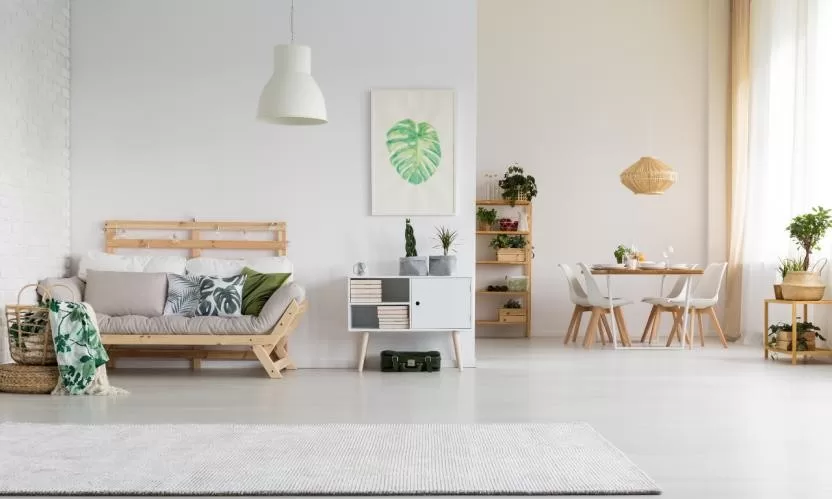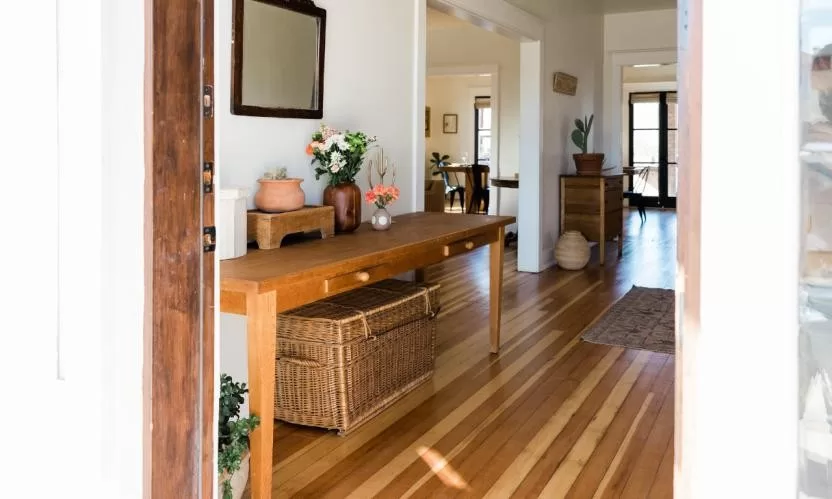Curation is not just for art, books, and music; it can also be applied to your home.
A well-curated home has items with a similar aesthetic and design sensibility—they all agree to the same vision.
Think about it like a gallery: if your pieces have something in common, they will hang together well. It’s not just about having things you like; it’s about having things that look good together.

So, how can you create a cohesive home using furniture?
Follow these tips.
How to Curate Furniture for a Cohesive Home
Establish a Colour Scheme

Consider how each piece of furniture will contribute to the overall color scheme. Sticking to a consistent palette will create a sense of harmony and balance throughout your space.
One way to make a statement while still maintaining a cohesive color scheme is by creating an obvious comparison between furniture pieces. For example, if you have a bold, statement-making sofa in vibrant color, pair it with a more neutral, understated chair or side table.
This will create visual interest and prevent your space from feeling too overwhelming.
Consider the different shades and tones within your chosen palette. You can use lighter shades for large furniture, such as sofas or bed frames. Then, incorporate darker or bolder colors for smaller accent pieces like pillows or rugs.
Create Flow

To create a natural flow between your rooms, consider using furniture with similar colors or styles for continuity.
Imagine walking from your living room to your dining room and feeling like you’re in a seamless transition rather than entering a completely different world.
Using furniture that shares common elements, such as a color palette or design style, achieves this desired flow.
But let’s not forget to have some fun with it! Think of your furniture as characters in a play, each with their own distinct personality. You want them to interact and complement each other like a well-rehearsed ensemble.
Maybe you could choose a living room sofa as the leading lady, elegant and sophisticated, while your dining room table is the charismatic, charming leading man.
And let’s not forget the supporting cast of chairs, side tables, and accessories, all working together to create a cohesive storyline.
Consider The Style

When choosing the style for your space, think about the overall aesthetic you want to achieve.
Read Also :
The vibe of your home really hinges on the style of your furniture, crafting a unified and visually satisfying atmosphere.
Consider these tips to curate furniture that perfectly complements your desired style:
- Embrace the minimalist trend: If you’re going for a modern and sleek look, opt for furniture with clean lines and minimal ornamentation. Think sleek sofas, minimalist coffee tables, and streamlined storage solutions. Keep the color palette simple and stick to neutral tones for a clean and cohesive feel.
- Go rustic for a cozy vibe: If you’re drawn to the warmth and charm of a rustic aesthetic, choose furniture made with natural materials like wood and leather. Don’t be afraid to mix and match different wood finishes for a more eclectic look.
- Timeless elegance with a traditional style: If you appreciate classic and timeless design, opt for furniture with elegant details and refined silhouettes. Think tufted sofas, ornate coffee tables, and richly stained wooden pieces. Incorporate luxurious fabrics like velvet or silk for an added touch of sophistication.
- Eclectic and bohemian: If you’re a fan of vibrant colors, bold patterns, and a mix of styles, embrace the eclectic and bohemian aesthetic. Incorporate statement pieces like a Moroccan-inspired rug or a vintage velvet armchair.
Use Symmetry and Balance

Achieving symmetry and balance in your space will create a visually pleasing and harmonious atmosphere. It’s like finding the perfect balance between jelly and peanut butter – a match made in design heaven.
You want to make sure that everything is well-balanced in terms of size, color, and texture. Think Goldilocks – not too big, not too small, just right.
To find that perfect balance, consider the placement of your furniture. Balanced proportions and symmetrical arrangements create a visual flow that’s oh-so-satisfying. It’s like a beautifully choreographed dance, where every piece of furniture has its place and moves gracefully with the others.
Incorporate Repetition

Incorporating repetition throughout your space creates a sense of flow and cohesion, making your home feel unified and visually appealing.
It’s like having a catchy tune that keeps playing in your head, but instead of annoying you, it actually makes you happy. You know, like that one song, you can’t help but dance to it, even though you’ve no rhythm whatsoever.
Well, the same principle applies to your home. By using consistent trims, stains, furniture material, door handles, and flooring, you create a harmonious environment that just makes you want to break out into a spontaneous, happy dance.
Imagine walking from room to room and feeling like you’re on a seamless journey. No sudden changes or jarring transitions. It’s just a smooth flow that takes you from one space to another without missing a beat.
Repetition in your home is like the secret sauce that ties everything together. So, go ahead and embrace the power of repetition.
Don’t Be Afraid Of Negative Space

Don’t worry about leaving empty spaces in your rooms; they can enhance the overall look and feel of your space.
One way to create negative space using furniture is to opt for simple and minimalistic furniture pieces. Choosing pieces that are visually light, such as tables with thin legs or chairs with open backs, can help create a sense of openness and airiness in a space, while also leaving more visible negative space.
It can also be helpful to arrange furniture in groupings, rather than spreading individual pieces out, as this can create more clearly defined negative space in between groupings.
Here are four reasons why you shouldn’t be afraid of negative space:
- Room to breathe: Just like taking a deep breath after a long day, negative space allows your furniture to have some breathing room.
- Highlighting the stars: By giving your furniture some space, you will enable each piece to shine and become a focal point. It’s like showing your sofa the red carpet treatment it deserves.
- Visual rhythm: Negative space acts as a visual rhythm, allowing your eyes to move freely around the room.
- Balance in asymmetry: Negative space is the superhero that saves the day when you have asymmetrical furniture arrangements. It adds a touch of equilibrium and prevents your room from feeling lopsided.
Use Consistent Flooring

Having consistent flooring throughout your space creates a seamless and connected look. It’s like having a smooth transition between different areas of your home, making it feel cohesive and well put together.
Here are four tips to help you curate furniture for a cohesive home with consistent flooring:
- Choose one type of flooring: Stick to a single type of material, whether hardwood, tile, or carpet.
- Consider the color palette: If you opt for a neutral color palette for your flooring, it will effortlessly blend with any furniture style or color scheme. You can switch up your decor without worrying about mismatched flooring.
- Use rugs strategically: Area rugs can be your secret weapon in tying together different furniture groupings and defining specific spaces within an open floor plan. Choose rugs that complement your flooring.
- Pay attention to transitions: If you’ve to transition from one type of flooring to another, make sure it’s done seamlessly. Use transition furniture pieces or design elements that smoothly connect the two surfaces.
Frequently Asked Questions (FAQs)
What are some tips for creating a flow between different rooms in my home?
Creating a smooth flow between different rooms is important for aesthetic and practical reasons.
Here are a few tips to help you achieve this:
- Choose a consistent color palette: Use a consistent color palette throughout different rooms to keep the flow consistent and visually connected.
- Use lighting to your advantage: Pay attention to the lighting in each room as it affects the atmosphere and mood. Use similar lighting fixtures or styles in rooms that are connected to each other.
- Coordinate furniture and decor: Choose furniture and decor that matches and create a cohesive look throughout the home.
- Consider the layout: Think about the layout of each room and how it connects to other areas of the house. Minimize visual obstructions by arranging furniture and décor to create an open flow between spaces.
- Add natural elements: Incorporate plants or other natural elements to create continuity throughout the home.
How can I use accessories to enhance the overall cohesion of my home design?
Using accessories strategically can enhance the overall cohesion of your home design. Start by selecting accessories that match the style and color scheme of your space.
Choose key pieces that are focal points and accentuate the room’s theme. Leverage things like art pieces, decorative cushions, area rugs, and drapes to tie together a harmonious color scheme in your living space.
Is it possible to achieve a cohesive home design while incorporating bold or vibrant colors?
Yes, it is possible to achieve a cohesive home design while incorporating bold or vibrant colors. The key is to use these colors purposefully and strategically. Start by selecting a color palette that includes both bold and neutral colors.
Use the bolder colors sparingly as accents in the room rather than overwhelming the space with them. Choose a few furnishings with bold colors and use them to create focal points in the room.
Conclusion
Your home shouldn’t be a random collection of furniture, accessories, and decor. It should be a reflection of who you are and what your style is (or can become).
Instead of buying furniture that doesn’t fit your style, use these tips to curate furniture for a cohesive home.
You’ll feel more at ease in your space and have the confidence to show off your home.









